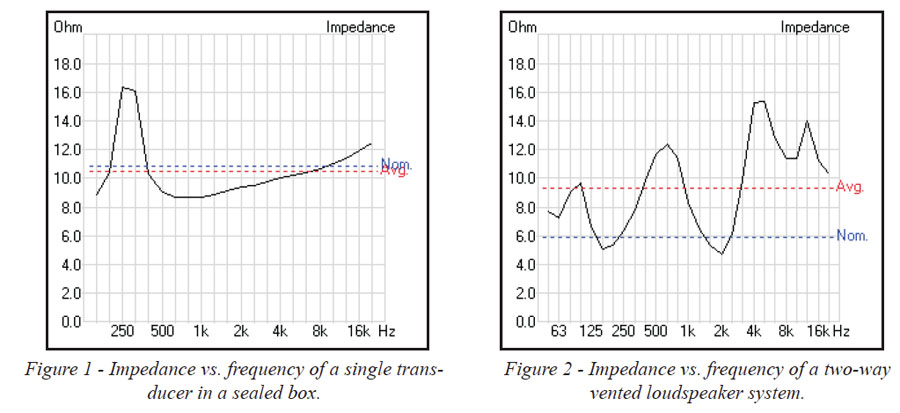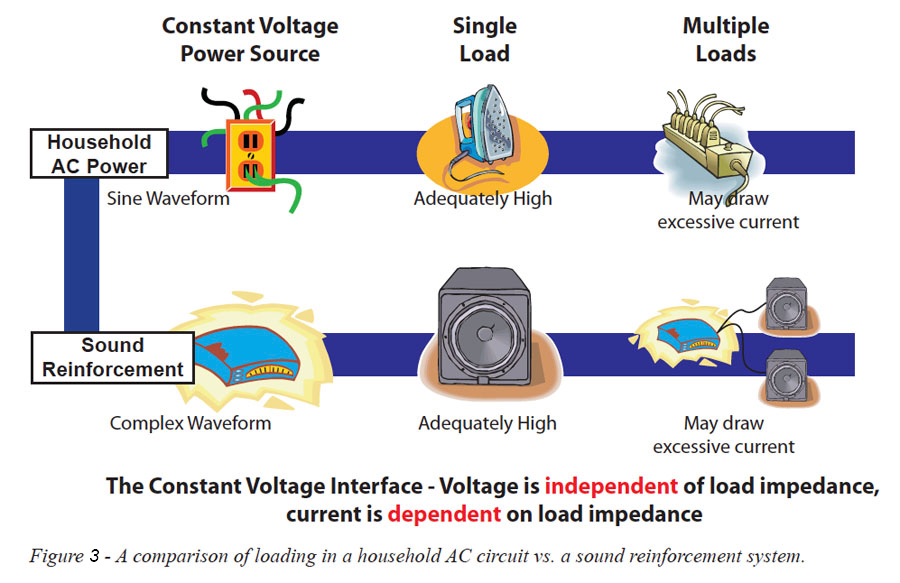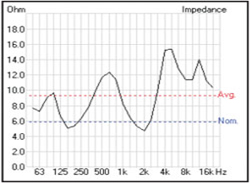The impedance of a loudspeaker characterizes the opposition that it presents to current flowing from the amplifier.
The impedance is both complex and frequency-dependent. Complex means that it is not a pure resistance, but a combination of resistance and reactance. As a result, the voltage and current waveforms from the amplifier are not in-phase.
Frequency-dependence means that the opposition to current flow varies with the applied frequency – a natural occurrence in a reactive load.
The curve in Figure 1 (below) shows the impedance of a single driver in a sealed box. The peak of the curve is the most striking feature. It is the resonant frequency of the loudspeaker/box system and usually falls near the useful low-frequency limit of the system.
The minima of the impedance curve is of greater significance and lies just above resonance. It represents the maximum load (minimum impedance) that the loudspeaker places on the amplifier.
The curve in Figure 2 (below, with Figure 1) shows the impedance of a typical 2-way loudspeaker system. The curve is “peakier” because of the box vent and multiple drivers.
So Why Should I Care?
In many cases you don’t need to care. Consider the way that we use electricity in our homes.
The wall outlet provides a fixed AC power source at a standard voltage (110 volts RMS sinusoid in the U.S.) and rated available current (typically 15 amps RMS).

The appliances that we use are designed to operate at this rated voltage. When they are plugged in and turned on they draw some nominal amount of current as determined by their impedance.
We seldom think about how much current is being drawn unless the appliance demands more than is available. In that case the circuit breaker trips and we investigate further as to the cause.
Most appliances draw far less than the available 15 amps so we just plug them in and use them without a second thought. Circuits of this type are termed “constant voltage” because the voltage does not change when the load is connected.
The current flow is determined by the impedance of the load, with load current increasing as impedance is reduced. The amplifier-to-loudspeaker interface works much the same way. The amplifier is a constant voltage source for the loudspeaker.

One difference between the amplifier and a household electrical outlet is that the voltage waveform from the amplifier contains information and is much more complex. Also, the voltage is not a fixed value (as with electrical outlets), but varies with the setting of the amplifier (Figure 3).
A notable exception is the high voltage distribution scheme used in distributed systems. In such systems the distribution voltage is fixed in value for a sinusoidal test tone (70.7 volts RMS in the U.S. and 100 volts RMS in Europe).
The actual voltage for speech and music waveforms is more complex and typically lower in value (30 volts RMS typical) as shown in Figure 4, below.





















